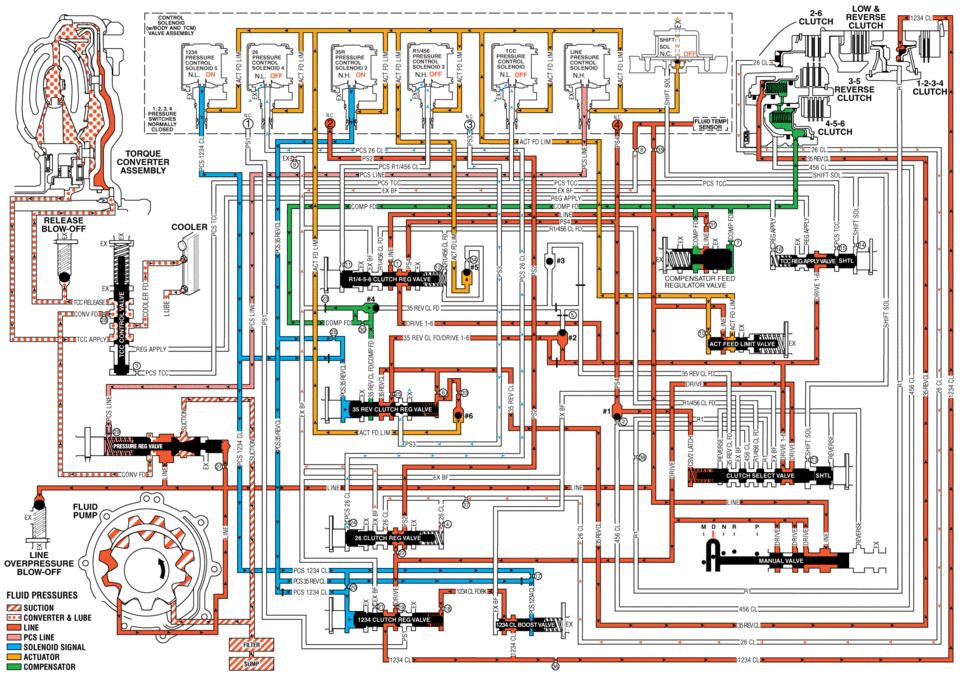Chevrolet Sonic Repair Manual: Drive Range, Third Gear (Gen 1)
As vehicle speed increases and operating conditions become appropriate, the transmission control module (TCM) processes input signals from the automatic transmission input and output speed sensors, the throttle position sensor and other vehicle sensors to determine the precise moment to command OFF the normally-low 26 pressure control solenoid 4. At the same time the 35R pressure control solenoid 2 is also commanded ON to regulate 3-5 clutch apply, and the transmission shifts into Third gear. The manual valve remains in the Drive (D) position and line pressure continues to feed the drive fluid circuit.
- 3-5-Reverse Clutch Applies
-
35R Pressure Control (PC) Solenoid 2
The 35R PC solenoid 2 is commanded ON, allowing actuator feed limit fluid to enter the PCS 35 reverse clutch fluid circuit. PCS 35 reverse clutch fluid is routed through orifice #26 to the 3-5-reverse clutch regulator valve.
3-5-Reverse Clutch Regulator Valve
PCS 35 reverse clutch fluid, at the 3-5-reverse clutch regulator valve, opposes 3-5-reverse clutch regulator valve spring force and 35 reverse clutch feedback fluid pressure to regulate 35 reverse clutch feed/drive 1-6 pressure into the 35 reverse clutch circuit. The 35 reverse clutch fluid is then routed to the 3-5-reverse clutch assembly, through orifice #6 to the spring end of the 3-5-reverse clutch regulator valve and through orifice #33 to the #6 ball check valve. When the 3-5-reverse clutch regulator valve is in this position, PS3 fluid exhausts through the valve allowing the normally-closed #3 pressure switch to close.
3-5-Reverse Clutch
35 reverse clutch fluid enters the 3-5-reverse and 4-5-6 clutch housing assembly to move the 3-5 reverse clutch piston against spring force and compensator feed fluid pressure to apply the 3-5-reverse clutch plates.
#6 Ball Check Valve
#6 Ball Check Valve 35 reverse clutch feed fluid unseats the #6 ball check valve, allowing excess pressure to pass into the actuator feed limit circuit. This helps to control clutch apply fluid pressure and clutch apply feel.
- 2-6 Clutch Releases
-
26 Pressure Control (PC) Solenoid 4
The 26 PC solenoid 4 is commanded OFF, allowing PCS 26 clutch fluid to exhaust from the 2-6 clutch regulator valve.
2-6 Clutch Regulator Valve
2-6 clutch regulator valve spring force moves the valve to the released position, allowing 26 clutch fluid from the 2-6 clutch to pass through the valve and enter the exhaust backfill fluid circuit. With the 2-6 clutch regulator valve in this position, drive fluid passes through the valve into the PS2 circuit. PS2 fluid is routed to the normally-closed #2 pressure switch and opens the switch.
2-6 Clutch
2-6 clutch spring force moves the 2-6 clutch piston to release the 2-6 clutch plates and force 26 clutch fluid to exhaust from the transmission case assembly. The exhausting 26 clutch fluid pressure is routed to the 2-6 clutch regulator valve where it enters the exhaust backfill fluid circuit.
- Drive Range, Third Gear

release 2-6 clutch low clutch reverse cl nl on ze n.l off smzuonna n.h on nh on: fd um nl or: torque pcs cl converter assemblv cooler lin 3-5 reverse 4-5-6 clutch pcs tdc fluid pressures suction converter lube line pcs line solenoid actuator compensatdr compensator feed regulator valve sol
 Drive Range, Sixth Gear (Gen 2)
Drive Range, Sixth Gear (Gen 2)
As vehicle speed increases, the transmission control module (TCM) processes input
signals from the automatic transmission input and output speed sensors, the throttle
position sensor and other veh ...
 Drive Range, Third Gear (Gen 2)
Drive Range, Third Gear (Gen 2)
As vehicle speed increases and operating conditions become appropriate, the transmission
control module (TCM) processes input signals from the automatic transmission input
and output speed sensors ...
Other materials:
Parking Brake Lever Replacement
Removal Procedure
Remove the front floor console. Refer to Front Floor Console Replacement.
Ensure that the park brake lever is in the fully released position.
Disconnect the electrical connector from the park brake warning lamp
switch.
Using ONLY HAND TOOL ...
Turn Signal Switch Bracket Replacement
Turn Signal Switch Bracket Replacement
Callout
Component Name
Preliminary Procedure
Remove the inflatable restraint steering wheel module coil. Refer to
Steering Wheel Airbag Coil Replacement.
1
...
Manual Shift Detent Lever with Shaft Position Switch Assembly and Park Pawl
Actuator Installation
Table 1:
Park Pawl Actuator Guide Installation
Table 2:
Park Pawl Actuator Installation
Park Pawl Actuator Guide Installation
Park Pawl Actuator Guide Installation
Callout
Component Name
...
0.0081
